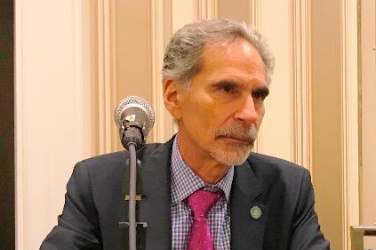AT THE ASA ANNUAL MEETING
SAN DIEGO (FRONTLINE MEDICAL NEWS) – A technique that causes tumors to glow allowed surgeons to identify pulmonary adenocarcinomas accurately and quickly in the operating room, according to findings presented at the annual meeting of the American Surgical Association.
The molecular imaging technique, dubbed an “optical biopsy,” was 100% accurate in identifying pulmonary adenocarcinomas in wedge resection of lung nodules. Using an agent derived from fireflies, Dr. Sunil Singhal and his associates at the University of Pennsylvania, Philadelphia, tagged a ligand specific to lung adenocarcinoma and infused patients with the preparation before surgery so that cancerous nodules would light up in the operating room.
About 800,000 surgeries for cancer are performed in the United States annually, and surgery remains the most effective overall treatment since it affords the opportunity for complete resection and accurate staging, but technical challenges presist in many cancer surgeries, including the difficulty of ensuring negative margins, identifying in situ disease, and ascertaining which lymph nodes are malignant, Dr. Singhal noted.
“We depend on our hands, eyes and intuition,” he said. “This is fallible.”
The molecular imaging technique developed by Dr. Singhal and his colleagues has the potential to improve surgical precision by giving surgeons a clear visual indication of which tissue is malignant and needs to be excised. The technique identifies a receptor specific to a particular type of cancer cell and tags an appropriate ligand with a molecule that glows – a fluorophore – before surgery. With uptake of the tagged ligand, the tumor cells glow visibly and are clearly identified during surgery.
The small proof-of-principle study used fluorescein bound to a folate ligand for folate receptor alpha (FRalpha). This receptor is specific to pulmonary adenocarcinoma, the most commonly diagnosed cancer among the approximately 250,000 solitary pulmonary nodules detected as incidental findings on CT scans.
The 30 solitary pulmonary nodules in the study underwent a wedge resection and an optical biopsy, since patients had all received the fluorescein-tagged ligand infusion before surgery. Nineteen of the tumors fluoresced and were provisionally identified as pulmonary adenocarcinoma. Of the 11 that did not fluoresce, five were later identified as benign, three were other types of lung cancer, and three represented metastatic disease.
All nodules also were subject to frozen section, with provisional identification of 13 as lung adenocarcinoma, 8 as cancer of unknown origin, 6 as benign, 2 as metastatic renal adenocarcinoma, and 1 as a nonadenocarcinoma lung cancer.
One of the nodules read as benign on frozen section had been correctly identified as pulmonary adenocarcinoma by optical biopsy, which had 100% positive predictive value for pulmonary adenocarcinoma in this series, according to Dr. Singhal.
He stressed, however, that this technique should not be viewed as a replacement for pathology, but rather as an adjunct.
“If the tumor glows, we predict lung adenocarcinoma. If the tumor does not glow, we have no information and we follow the standard of care,” he said.
Going forward, Dr. Singhal and his colleagues plan to identify other candidate ligands for tagging, as well as developing fluorophores in a variety of colors. These could be infused simultaneously and allow differentiation between various tumor types. They also are developing materials that glow in the near-infrared spectrum and are detectable by specialized cameras.
Discussant Dr. Fabrizio Michelassi, chairman of the department of surgery at Weill Cornell Medical College and surgeon-in-chief at New York-Presbyterian/Weill Cornell Medical Center, asked whether the technique would be useful in identifying malignant sites in a diffusely inflamed field. Addressing the examples of Barrett’s esophagus and Crohn’s disease, Dr. Singhal affirmed the utility of optical biopsy in these conditions.
“As long as you have blood supply to that location, you can use whatever molecular contrast agent you want,” he said.
Dr. David Harpole, vice chief of the division of surgical services at Duke University Medical Center, applauded Dr. Singhal and his colleagues for taking a pertinent clinical problem to the laboratory. “Rapid intraoperative assessment of suspicious nodules is important,” he said, calling for a multi-institutional prospective cohort analysis to move the work forward.
The investigators reported no relevant financial disclosures. The study was supported by the National Institutes of Health, the Department of Defense, and the Veterans Health Administration.
acssurgerynews@frontlinemedcom.com




